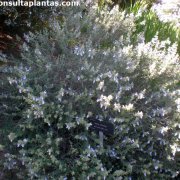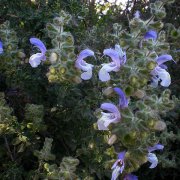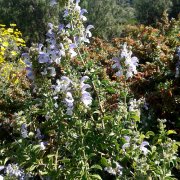Care of the shrub Salvia africana or Blue African sage |
|
The genus Salvia, family Lamiaceae, comprises 1,000 species of shrubs and herbaceous plants native to Asia, Africa, the Mediterranean region, and Central and South America. Some species are: Salvia africana, Salvia scabra, Salvia apiana, Salvia lanceolata, Salvia canariensis, Salvia farinacea, Salvia leucantha, Salvia guaranitica, Salvia namaensis, Salvia greggii, Salvia microphylla, Salvia mexicana, Salvia splendens, Salvia disermas, Salvia vaseyi, Salvia leucophylla, Salvia verbenacea, Salvia sclarea, Salvia mellifera, Salvia nemorosa, Salvia officinalis, Salvia aurea, Salvia fruticosa, Salvia elegans, Salvia x sylvestris. Common names: Blue African sage, Blue sage, African sage, Purple sage. This species is native to Cape Provinces, South Africa. They are highly branched evergreen hairy shrubs that reach 2 meters (6.56 feet) in height. The leaves are aromatic, grayish green in color and oval in shape. They produce numerous blue (sometimes pink) flowers that attract butterflies and bees. They bloom from mid-winter to mid-summer but can bloom most of the year. This easy-to-grow plant are used to form bushy groups (combined with other Salvias), on dry slopes and as isolated specimens. Blue African sage is ideal for Mediterranean gardens. It has medicinal properties: infusions against cough can be prepared with their fresh leaves to which honey and lemon are added. Salvia africana needs full sun exposure and high temperatures. It resists occasional frosts. The soil must be well drained because excess water can rot the plant. Water moderately, waiting for the substrate to dry; African sage is a drought resistant plant. Young plants appreciate a light supply of liquid organic fertilizer each month in spring and summer. Prune lightly after flowering to favor the next flowering. Salvia africana is a resistant plant to the usual pests and diseases. Blue sage is propagated from seeds sown in spring or by cuttings from the base of the plant. |
Images of the shrub Salvia africana or Blue African sage |
Find plants
Salvia africana or Blue African sage | Care and Growing
© 2026 FavThemes


